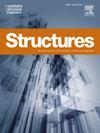Structural failure of reinforced concrete buildings: The case of Al Haouz earthquake on 8 September 2023, Morocco
IF 3.9
2区 工程技术
Q1 ENGINEERING, CIVIL
引用次数: 0
Abstract
On 8 September 2023, Morocco was subjected to a significant seismic event. The earthquake occurred at 11:11 PM with a magnitude of Mw 6.8–7.2 in the province of Al Haouz. The epicenter of the earthquake was located at 30.9896 North; 8.4140 West, in the rural commune of Ighil, province of Al Haouz, Marrakech-Safi region. The Al Haouz earthquake had a significant impact on buildings, particularly in five provinces (Al Haouz, Chichaoua, Marrakech, Ouarzazate and Taroudant). The earthquake caused significant damage and loss of life in the affected regions, with a total of 69,674 buildings were damaged, 47,378 were partially destroyed, and 22,296 were totally destroyed. An analysis was conducted to assess the damage to reinforced concrete buildings in each of the two regions namely Al Haouz and Taroudant. The results indicated that the main causes of the observed damage were attributable to the nature of the soil, the short columns, soft story, the lack of sufficient reinforcement, and the construction materials used. An evaluation was conducted to assess compliance with Moroccan seismic regulations (RPS 2011) and identify deficiencies requiring revisions to the standard. This assessment also involved a comparison with other international seismic regulations, such as those in China and Eurocode 8, to examine best practices and learn valuable lessons. This comparative approach aims to enhance local standards by incorporating proven approaches to improving the seismic resistance of structures.
求助全文
约1分钟内获得全文
求助全文
来源期刊

Structures
Engineering-Architecture
CiteScore
5.70
自引率
17.10%
发文量
1187
期刊介绍:
Structures aims to publish internationally-leading research across the full breadth of structural engineering. Papers for Structures are particularly welcome in which high-quality research will benefit from wide readership of academics and practitioners such that not only high citation rates but also tangible industrial-related pathways to impact are achieved.
 求助内容:
求助内容: 应助结果提醒方式:
应助结果提醒方式:


